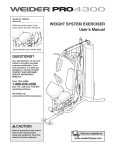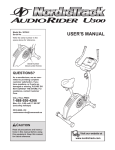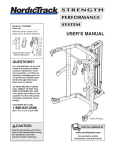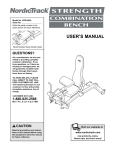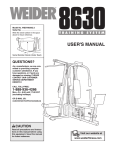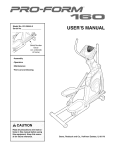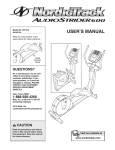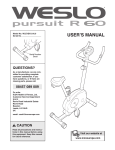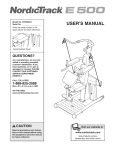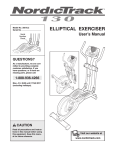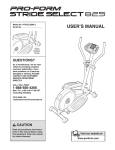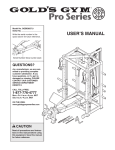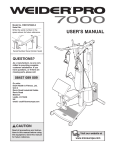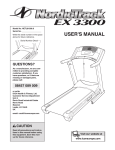Download USER`S MANUAL
Transcript
Model No. 30806.0 Serial No. Write the serial number in the space above for future reference. USER’S MANUAL Serial Number Decal (Under Seat) QUESTIONS? As a manufacturer, we are committed to providing complete customer satisfaction. If you have questions, or if parts are damaged or missing, PLEASE CONTACT OUR CUSTOMER SERVICE DEPARTMENT DIRECTLY. CALL TOLL-FREE: 1-888-936-4266 Mon.–Fri., 8:00 until 17:00 EST (excluding holidays) OR E-MAIL US: [email protected] CAUTION Read all precautions and instructions in this manual before using this equipment. Save this manual for future reference. w Visit our website at www.nordictrack.com TABLE OF CONTENTS WARNING DECAL PLACEMENT . . . . . . . . . . . . . . . . . . . . . . . . . . . . . . . . . . . . . . . . . . . . . . . . . . . . . . . . . . . . . 2 IMPORTANT PRECAUTIONS . . . . . . . . . . . . . . . . . . . . . . . . . . . . . . . . . . . . . . . . . . . . . . . . . . . . . . . . . . . . . . . . 3 BEFORE YOU BEGIN . . . . . . . . . . . . . . . . . . . . . . . . . . . . . . . . . . . . . . . . . . . . . . . . . . . . . . . . . . . . . . . . . . . . . . 4 ASSEMBLY . . . . . . . . . . . . . . . . . . . . . . . . . . . . . . . . . . . . . . . . . . . . . . . . . . . . . . . . . . . . . . . . . . . . . . . . . . . . . . 5 ADJUSTMENTS . . . . . . . . . . . . . . . . . . . . . . . . . . . . . . . . . . . . . . . . . . . . . . . . . . . . . . . . . . . . . . . . . . . . . . . . . .12 WEIGHT RESISTANCE CHART . . . . . . . . . . . . . . . . . . . . . . . . . . . . . . . . . . . . . . . . . . . . . . . . . . . . . . . . . . . . . .16 CABLE DIAGRAM . . . . . . . . . . . . . . . . . . . . . . . . . . . . . . . . . . . . . . . . . . . . . . . . . . . . . . . . . . . . . . . . . . . . . . . . .17 EXERCISE GUIDELINES . . . . . . . . . . . . . . . . . . . . . . . . . . . . . . . . . . . . . . . . . . . . . . . . . . . . . . . . . . . . . . . . . . 18 ORDERING REPLACEMENT PARTS . . . . . . . . . . . . . . . . . . . . . . . . . . . . . . . . . . . . . . . . . . . . . . . . . .Back Cover LIMITED WARRANTY . . . . . . . . . . . . . . . . . . . . . . . . . . . . . . . . . . . . . . . . . . . . . . . . . . . . . . . . . . . . . . Back Cover Note: A PART IDENTIFICATION CHART and a PART LIST/EXPLODED DRAWING are attached in the center of this manual. Remove the PART IDENTIFICATION CHART and PART LIST/EXPLODED DRAWING before beginning assembly. WARNING DECAL PLACEMENT The decals shown here have been placed on the weight system. If a decal is missing or illegible, call the telephone number on the front cover of this manual and order a free replacement decal. Apply the decal in the location shown. ATTENTION Part # 166295 NordicTrack is a registered trademark of ICON IP, Inc. 2 IMPORTANT PRECAUTIONS WARNING: To reduce the risk of serious injury, read the following important precautions before using the weight system. 1. Read all instructions in this manual and all warnings on the weight system before using the weight system. Use the weight system only as described in this manual. 10. Make sure that the cables remain on the pulleys at all times. If the cables bind as you are exercising, stop immediately and make sure that the cables are on the pulleys. Replace all cables at least every two years. 2. It is the responsibility of the owner to ensure that all users of the weight system are adequately informed of all precautions. 11. Always stand on the base plate when performing an exercise that could cause the weight system to tip. 3. The weight system is intended for home use only. Do not use the weight system in any commercial, rental, or institutional setting. 12. Never release the handles, leg lever, squat bar, ankle strap, or curl bar while weights are raised; the weights will fall with great force. 4. Keep the weight system indoors, away from moisture and dust. Place the weight system on a level surface, with a mat beneath it to protect the floor or carpet. Make sure that there is enough clearance around the weight system to mount, dismount, and use the weight system. 13. Do not use the weight system with the top weight pinned in an elevated position. 14. Use the weight system only with the included weight. Do not use the weight system with any other type weight to add resistance. 5. Inspect and properly tighten all parts regularly. Replace any worn parts immediately. 15. Always secure the weight stack with the lock pin and lock after exercising to prevent unauthorized use of the weight system (see LOCKING THE WEIGHT STACK on page 15). 6. Keep children under 12 and pets away from the weight system at all times. 16. Always make sure that the pins and knobs are fully engaged before using the weight system. 7. Keep hands and feet away from moving parts. 8. Always wear athletic shoes for foot protection while exercising. 17. If you feel pain or dizziness at any time while exercising, stop immediately and begin cooling down. 9. The weight system is designed to support a maximum user weight of 300 pounds. WARNING: Before beginning this or any exercise program, consult your physician. This is especially important for persons over the age of 35 or persons with pre-existing health problems. Read all instructions before using. ICON assumes no responsibility for personal injury or property damage sustained by or through the use of this product. 3 BEFORE YOU BEGIN reading this manual, please see the front cover of this manual. To help us assist you, please note the product model number and serial number before calling. The model number is 30806.0. The serial number can be found on a decal attached to the weight system (see the front cover of this manual). Thank you for selecting the versatile NordicTrack® 360° WITH FREEMOTION TECHNOLOGY weight system. The weight system offers a selection of weight stations designed to develop every major muscle group of the body. Whether your goal is to tone your body, build dramatic muscle size and strength, or improve your cardiovascular system, the weight system will help you to achieve the specific results you want. Before reading further, please review the drawing below and familiarize yourself with the parts that are labeled. For your benefit, read this manual carefully before using the weight system. If you have questions after ASSEMBLED DIMENSIONS: Height: 85 in. / 216 cm Width: 75 in. / 191 cm Depth: 61 in. / 155 cm Weight: 150 lbs. / 68 kg Dip Handle Dip Arm Knob Dip Arm Backrest Dip Arm Pin Press Arm Knob Press Arm Right Side Curl Pad Weight Pin Weight Seat Locking Caster Pulley Housing Leg Developer Extension Strap Base Handle Squat Bar Left Side Curl Bar Ankle Strap Note: The terms “right side” and “left side” are determined relative to a person sitting on the seat; they do not correspond to right and left on the drawings in the manual. 4 ASSEMBLY • Tighten all parts as you assemble them, unless instructed to do otherwise. Make Assembly Easier Everything in this manual is designed to ensure that the weight system can be assembled successfully by almost anyone. However, the weight system has many parts and the assembly process will take time. By setting aside plenty of time, assembly will go smoothly. • As you assemble the weight system, make sure all parts are oriented as shown in the drawings. • For help identifying small parts, use the PART IDENTIFICATION CHART. The included hex key and grease, and the following tools (not included) may be required for assembly: Before beginning assembly, carefully read the following information and instructions: • Two adjustable wrenches • Assembly requires two persons. • One rubber mallet • Because of its weight and size, the weight system should be assembled in the location where it will be used. Make sure that there is enough clearance to walk around the weight system as you assemble it. • One standard screwdriver • One Phillips screwdriver • Clear tape or masking tape, and soapy water. • Place all parts in a cleared area and remove the packing materials. Do not dispose of the packing materials until assembly is completed. 1. Assembly will be more convenient if you have a socket set, a set of open-end or closed-end wrenches, or a set of ratchet wrenches. 1 Before beginning assembly, make sure you understand the information in the box above. For help identifying small parts, use the PART IDENTIFICATION CHART in the center of this manual. 99 1 94 Attach a Wheel (32) to a Wheel Cap (31) with an M8 x 65mm Button Bolt (94) and an M8 Nylon Locknut (110). Do not overtighten the Nylon Locknut; the Wheel must pivot easily. 32 31 110 99 31 Attach the Wheel Cap (31) to the Base (1) with two M4 x 16mm Self-tapping Screws (99). 2 Repeat this step with the other Wheel Cap (31). 92 76 92 2. Attach a Locking Caster (76) to the Base (1) with four M8 x 20mm Button Bolts (92) and four M8 Nylon Locknut (110). 1 Repeat this step with the other Locking Caster (76). 76 110 5 110 3. Press the 89mm Round Cap (39) into the Upright (3). 3 39 Insert four M10 x 55mm Carriage Bolts (83) up through the Base (1). Note: Covering the bolt heads with a piece of tape will help hold them in place. Attach the Upright (3) to the Base with the four Bolts and four M10 Nylon Locknuts (108). Do not tighten the Nylon Locknuts yet. 3 108 108 1 83 83 4. Note: The parts in steps 7, 13, and 14 may be preassembled. If the Press Arm Cable (not shown) is preattached, make sure that it goes over the Dip Arm (5) as this step is completed. 4 Hole 5 Apply grease to an M10 x 115mm Bolt (84). Attach the Dip Arm (5) to the Upright (3) with the Bolt and an M10 Nylon Locknut (108). Make sure that the Bolt is inserted through the indicated hole in the Dip Arm. Do not overtighten the Nylon Locknut; the Dip Arm must pivot easily. 108 3 Attach the Dip Arm Pin (53) to the Dip Arm (5) with an M4 x 13mm Self-tapping Screw (112). Insert the Pin into the Dip Arm and the Upright (3). 53 112 84 Grease 6 5. Attach the Weight Guide (13) to the Base (1) with an M10 x 50mm Bolt (96), two M10 Washers (105), an 16mm x 6mm Spacer (11), and an M10 Nylon Locknut (108). 5 16 79 Attach the Weight Guide With Hole (36) to the Base (1) in the same manner. Make sure that the indicated hole in the Weight Guide is closer to the bottom. 13 36 27 Locate the fourteen Weights (27) that do not have Weight Bushings (30) pressed into them. Press two Weight Bushings into the outside holes of each Weight. Make sure that all of the Weights are oriented as shown, with the pin holes on the bottom. 30 27 Pin Hole Slide two Weight Bumpers (29) onto the Weight Guides (13, 36). Slide the fourteen Weights (27) onto the Weight Guides. Hole 29 96 Insert the Weight Tube (16) into the center hole in the fifteenth Weight (27). Tap the Roll Pin (79) into the top hole in the Weight Tube. Make sure that the Roll Pin is underneath the Weight and is centered in the Weight Tube. 105 108 11 1 Slide the Weight (27) onto the Weight Guides (13, 36). 6. See drawing 6b. Attach the Front Shroud (14) to the Base (1) with an M4 x 16mm Self-tapping Screw (99). 6a 24 See drawing 6a. Note: If the Press Arm Cable (not shown) has been routed through the Top Cover (24), make sure that the Cable crosses under the Top Frame (12) and hangs between the Weight Guides (13, 36) while this step is completed. 95 105 12 11 105 14 3 Attach the Top Frame (12) to the Weight Guides (13, 36) with two M10 x 65mm Bolts (95), four M10 Washers (105), two 16mm x 6mm Spacers (11), and two M10 Nylon Locknuts (108). Do not tighten the Nylon Locknuts yet. 108 13 36 91 Attach the Top Frame (12) to the Upright (3) with two M10 x 100mm Button Bolts (91) and an M10 Nylon Locknut (108). 6b Set the Top Cover (24) over the Front Shroud (14) and the Top Frame (12). 1 Tighten the M10 Nylon Locknuts (108) used in steps 3 and 6. 14 99 7 105 108 7. See the CABLE DIAGRAM on page 17 to ensure correct cable routing during steps 7 through 14. 7 66 Use the wire in the Left Press Arm (7) to pull the Press Arm Cable (66) up through the Press Arm. Make sure that the Cable is routed around the pulleys above the Press Arm as shown in the inset drawing. Hold a 4" Pulley (42) over the Press Arm Cable (66). Attach the Pulley inside of the Swivel Arm (26) with an M10 x 50mm Button Bolt (88), two M10 Washers (105), two 16mm x 6mm Spacers (11), and an M10 Nylon Locknut (108). 7 108 11 105 42 66 26 11 105 88 8. Route the Press Arm Cable (66) over a 3 1/2" Pulley (43). Attach the Pulley and a Cable Trap (47) to the Top Frame (12) with an M10 x 40mm Screw (97). Make sure that the Cable Trap is oriented to hold the Cable in the groove of the Pulley. 8 12 66 47 97 43 9. Route the Press Arm Cable (66) through the Top Cover (24) and over a 3 1/2" Pulley (43). Attach the Pulley and a Cable Trap (47) to the Top Frame (12) with an M10 x 40mm Screw (97). Make sure that the Cable Trap is oriented to hold the Cable in the groove of the Pulley. 9 24 12 66 47 97 43 10. Route the Press Arm Cable (66) under a 3 1/2" Pulley (43). Attach the Pulley, a Cable Trap (47), and two Finger Guards (48) to the second hole from the top of the Weight Tube (16) with an M10 x 50mm Bolt (96) and an M10 Nylon Locknut (108). Make sure that the Cable Trap is oriented to hold the Cable in the groove of the Pulley. 10 66 16 48 47 43 96 48 8 108 11. Route the Press Arm Cable (66) over a 3 1/2" Pulley (43). Attach the Pulley and a Cable Trap (47) to the Top Frame (12) with an M10 x 40mm Screw (97). Make sure that the Cable Trap is oriented to hold the Cable in the groove of the Pulley. 11 12. Route the Press Arm Cable (66) through the Top Cover (24) and over a 3 1/2" Pulley (43). Attach the Pulley and a Cable Trap (47) to the Top Frame (12) with an M10 x 40mm Screw (97). Make sure that the Cable Trap is oriented to hold the Cable in the groove of the Pulley. 12 47 43 97 66 12 24 47 43 12 97 66 13. Use the wire in the Right Press Arm (8) to pull the Press Arm Cable (66) down through the Press Arm. Make sure that the Cable is routed around the pulleys above the Press Arm as shown in the inset drawing. 13 66 Hold a 4" Pulley (42) over the Press Arm Cable (66). Attach the Pulley inside of the Swivel Arm (26) with an M10 x 50mm Button Bolt (88), two M10 Washers (105), two 16mm x 6mm Spacers (11), and an M10 Nylon Locknut (108). 8 88 105 11 11 42 26 105 66 14. Orient the Cable Cover (63) as shown and slide it onto the Press Arm Cable (66). 14 Insert the Press Arm Cable (66) into the Cable Coupler (64). Tighten four M6 x 10mm Set Screws (114) into the Coupler to hold the Cable in place. 66 114 64 Slide the Cable Cover (63) over the Cable Coupler (64). 63 114 9 108 15. See drawing 15a. Slide the Rear Shroud (15) under the Top Cover (24). 15a 24 99 99 Attach the Top Cover (24) and the Front and Rear Shrouds (14, 15) to the Top Frame (12) with three M4 x 16mm Self-tapping Screws (99). 12 15 14 See drawing 15b. Attach the Rear Shroud (15) to the Base (1) with an M4 x 16mm Self-tapping Screw (99). 15b 99 15 1 16. Attach the Backrest (18) to the Upright (3) with two M6 x 100mm Screws (113) and two M6 Washers (107). 16 3 113 107 18 113 107 17. Attach the Seat (19) to the Seat Frame (4) with two M6 x 16mm Screws (87) and an M6 x 85mm Screw (85). 17 19 Set the Seat Frame (4) onto a set of posts on the Upright (3). 4 85 18. Attach the Bumper (115) to the Leg Developer (6) with an M4 x 19mm Self-tapping Screw (100). 87 18 86 4 Grease Grease an M10 x 75mm Bolt (86). Attach the Leg Developer (6) to the Seat Frame (4) with the Bolt and an M10 Nylon Locknut (108). Do not overtighten the Nylon Locknut; the Leg Developer must pivot easily. 100 6 10 108 115 19. Attach a Front and Rear Dip Cap (33, 34) around a Dip Handle (10) with two M3 x 32mm Self-tapping Screws (102). 19 5 51 Tighten a Dip Arm Knob (51) into the Dip Arm (5). Pull the Knob out as far as it will go and insert the Dip Handle (10) through a Dip Arm Bushing (35) and into the Dip Arm. Engage the Knob into the Dip Handle. 102 10 35 33 34 102 Repeat this step on the other side of the Dip Arm (5). 20. Attach an Arm Pad (21) and an Arm Pad Base (22) to the Dip Arm (5) with two M6 x 70mm Screws (93). 20 21 Repeat this step on the other side of the Dip Arm (5). 22 5 93 21. Insert a Pad Tube (17) into the Leg Developer (6). Slide two Leg Pads (23) onto the Pad Tube. 21 Slide two Leg Pads (23) onto the Seat Frame (4). 23 4 23 23 17 6 23 22. Attach the Curl Pad (20) to the Curl Post (9) with two M6 x 16mm Screws (87). 22 20 9 23. Make sure that all parts are properly tightened before using the weight system. The use of the remaining parts will be explained in the ADJUSTMENTS section, beginning on the following page. 87 11 ADJUSTMENTS This section explains how to adjust the weight system. See the EXERCISE GUIDELINES on page 18 for important information about how to get the most benefit from your exercise program. Also, refer to the accompanying exercise guide to see the correct form for each exercise. Properly tighten all parts each time the weight system is used. Replace any worn parts immediately. The weight system can be cleaned with a damp cloth and a mild, non-abrasive detergent. Do not use solvents. ADJUSTING THE DIP HANDLES The Dip Handles (10) can be moved to three different lengths in the Dip Arm (5), and rotated in 90-degree increments. 5 10 To adjust a Dip Handle (10), disengage the Dip Arm Knob (51) and move the Dip Handle to the desired position. Reengage the Knob into the Handle. 51 10 ADJUSTING THE PRESS ARM To adjust a Press Arm (7 or 8), first disengage the Press Arm Knob (50). Move the Press Arm to the desired position, and reengage the Knob into the Adjustment Plate (25). 25 8 50 WARNING: Always make sure that the Press Arm Knob (50) fully engages the Adjustment Plate (25) before exercising. 7 ADJUSTING THE DIP ARM To adjust the Dip Arm (5), first make sure the press arms are in the lowered position (see ADJUSTING THE PRESS ARM above). Then, remove the Dip Arm Pin (53). Move the Dip Arm to the raised or lowered position. Reengage the Pin into the Upright (3) and the Dip Arm. 5 3 53 12 ADJUSTING THE SEAT 3 19 To adjust the height of the Seat (19), lift the Seat Frame (4) off of the Upright (3). Set the Seat Frame onto a different set of posts on the Upright. For some exercises, the Seat (19) should be removed from the weight system and stored where it will not interfere with the exercise. 4 ATTACHING THE CURL PAD 20 To use the Curl Pad (20), insert the Curl Post (9) into the Seat Frame (4). Secure the Curl Post with the Curl Knob (52). Store the Curl Pad (20) away from the weight system while performing exercises that do not require it. 52 9 4 ATTACHING THE PULLEY HOUSINGS The Pulley Housings (54) can be attached to the Upright (3) (leg developer position), or to the Base (1) (squat position or preacher curl position). 3 To attach a Pulley Housing (54), slide the hook on the Pulley Housing onto the bracket at the desired position. Attach the Housing Cable (71) to the Eyehook (65) with a Clip (61). 61 71 65 54 Leg Developer 1 Preacher Curl Squat ATTACHING THE LEG DEVELOPER To use the Leg Developer (6), first move the press arms to the lowered position (see ADJUSTING THE PRESS ARM on page 12). Then, attach the pulley housings to the leg developer position (see ATTACHING THE PULLEY HOUSINGS above). Then, attach the Housing Cables (71) to the Leg Developer using a Clip (61). 6 71 61 13 ATTACHING THE CURL BAR To use the Curl Bar (58), first attach the curl pad to the seat frame (see ATTACHING THE CURL PAD on page 13). Next, attach the pulley housings to the preacher curl position (see ATTACHING THE PULLEY HOUSINGS on page 13). Then, attach the Housing Cables (71) to the Leg Developer (6) with two Clips (not shown). Finally, attach the Curl Bar to the Leg Developer with a Clip (61). 58 6 71 61 ATTACHING THE SQUAT BAR 55 To use the Squat Bar (55), first remove the seat (see ADJUSTING THE SEAT on page 13). Then attach the pulley housings to the squat positions (see ATTACHING THE PULLEY HOUSINGS on page 13). Next, attach the Squat Bar to the Housing Cables (71) with four Clips (61) and the two Extension Straps (70). Finally, adjust the Extension Straps to the correct length. 61 70 61 ATTACHING THE HANDLES A Handle (69) can be attached to an Eyehook (65), or to a Housing Cable (not shown), with a Clip (61). For some exercises an Extension Strap (not shown) should be attached between the Eyehook or Cable and the Handle with two Clips. Adjust the Extension Strap to the correct length. 65 61 69 The Ankle Strap (not shown) can be attached in the same manner. 14 71 MOVING THE WEIGHT SYSTEM To move the weight system, step on the levers on the Locking Casters (76) to unlock the wheels. Move the weight system to the new location. Relock the wheels on the Locking Casters. Lever 76 CHANGING THE WEIGHT SETTING To change the setting of the weight stack, insert the Weight Pin (28) under the desired Weight (27). Insert the Weight Pin so that the bent end touches the weight stack. Turn the bent end down. 27 Note: Due to the cables and pulleys, the amount of resistance at each exercise station may vary from the weight setting. Use the WEIGHT RESISTANCE CHART on page 16 to find the approximate amount of resistance. 28 LOCKING THE WEIGHT STACK 36 To lock the weight stack, insert the Lock Pin (78) into the indicated hole in a Weight Guide With Hole (36). Insert the Lock (77) through the hole in the Weight Pin and close the Lock. 77 78 ADJUSTING THE CABLE 66 Woven cable, the type of cable used on the weight system, can stretch slightly when it is first used. If there is slack in the cable before resistance is felt, the cables should be tightened. 48 48 43 47 To tighten the cable, remove the M10 x 50mm Bolt (96) from the Weight Tube (16). Reattach the 3 1/2" Pulley (43), the Cable Trap (47), and the two Finger Guards (48) to a lower hole in the Weight Tube with the Bolt and an M10 Nylon Locknut (108). Make sure that the Cable Trap is oriented to hold the Press Arm Cable (66) in the groove of the Pulley. To loosen the Cable, attach the Pulley to a higher hole in the Weight Tube. 16 96 15 108 WEIGHT RESISTANCE CHART The chart below shows the approximate weight resistance for the 10 lb. weights. Note: The actual resistance at each station may vary due to differences in individual weight plates and to friction between the cables, pulleys, and weight guides. WEIGHT 1 2 3 4 5 6 7 8 9 10 11 12 13 14 15 Press Arm* 9 15 20 25 30 36 41 46 51 57 62 67 72 77 84 Leg Developer 20 30 42 50 65 73 92 97 108 125 137 144 159 170 180 *Weight resistance shown is for each arm. 16 CABLE DIAGRAM The cable diagram shows the proper routing of the Press Arm Cable (66). Use the diagram to make sure that the cable and the cable traps have been assembled correctly. If the cable has not been correctly routed, the weight system will not function properly and damage may occur. The numbers show the correct route for the cable. Make sure that the cable traps do not touch or bind the cable. 8 9 6 5 10 11 4 3 12 7 13 2 1 Press Arm Cable (66) 17 EXERCISE GUIDELINES THE FOUR BASIC TYPES OF WORKOUTS PERSONALIZING YOUR EXERCISE PROGRAM Muscle Building To increase the size and strength of your muscles, push them close to their maximum capacity. Your muscles will adapt and grow as you progressively increase the intensity of your exercise. You can adjust the intensity level of an individual exercise in two ways: • by changing the amount of weight used • by changing the number of repetitions or sets performed. (A “repetition” is one complete cycle of an exercise, such as one sit-up. A “set” is a series of repetitions.) Determining the exact length of time for each workout, as well as the number of repetitions or sets completed, is an individual matter. It is important to avoid overdoing it during the first few months of your exercise program. You should progress at your own pace and be sensitive to your body’s signals. If you experience pain or dizziness at any time while exercising, stop immediately and begin cooling down. Find out what is wrong before continuing. Remember that adequate rest and a proper diet are important factors in any exercise program. The proper amount of weight for each exercise depends upon the individual user. You must gauge your limits and select the amount of weight that is right for you. Begin with 3 sets of 8 repetitions for each exercise you perform. Rest for 3 minutes after each set. When you can complete 3 sets of 12 repetitions without difficulty, increase the amount of weight. WARMING UP Toning You can tone your muscles by pushing them to a moderate percentage of their capacity. Select a moderate amount of weight and increase the number of repetitions in each set. Complete as many sets of 15 to 20 repetitions as possible without discomfort. Rest for 1 minute after each set. Work your muscles by completing more sets rather than by using high amounts of weight. WORKING OUT Begin each workout with 5 to 10 minutes of stretching and light exercise to warm up. Warming up prepares your body for more strenuous exercise by increasing circulation, raising your body temperature and delivering more oxygen to your muscles. Each workout should include 6 to 10 different exercises. Select exercises for every major muscle group, emphasizing areas that you want to develop most. To give balance and variety to your workouts, vary the exercises from session to session. Schedule your workouts for the time of day when your energy level is the highest. Each workout should be followed by at least one day of rest. Once you find the schedule that is right for you, stick with it. Weight Loss To lose weight, use a low amount of weight and increase the number of repetitions in each set. Exercise for 20 to 30 minutes, resting for a maximum of 30 seconds between sets. EXERCISE FORM Cross Training Cross training is an efficient way to get a complete and well-balanced fitness program. An example of a balanced program is: • Plan strength training workouts on Monday, Wednesday, and Friday. • Plan 20 to 30 minutes of aerobic exercise, such as running on a treadmill or riding on an exercise cycle or an elliptical exerciser, on Tuesday and Thursday. • Rest from both strength training and aerobic exercise for at least one full day each week to give your body time to regenerate. The combination of strength training and aerobic exercise will reshape and strengthen your body, plus develop your heart and lungs. Maintaining proper form is an essential part of an effective exercise program. This requires moving through the full range of motion for each exercise, and moving only the appropriate parts of the body. Exercising in an uncontrolled manner will leave you feeling exhausted. On the exercise guide accompanying this manual you will find photographs showing the correct form for several exercises, and a list of the muscles affected. Refer to the muscle chart on the next page to find the names of the muscles. The repetitions in each set should be performed smoothly and without pausing. The exertion stage of each repetition should last about half as long as the return stage. Proper breathing is important. Exhale during the exertion stage of each repetition and inhale during the return stroke. Never hold your breath. 18 slowly as you stretch and do not bounce. Ease into each stretch gradually and go only as far as you can without strain. Stretching at the end of each workout is an effective way to increase flexibility. Rest for a short period of time after each set. The ideal resting periods are: • Rest for three minutes after each set for a muscle building workout. • Rest for one minute after each set for a toning workout. • Rest for 30 seconds after each set for a weight loss workout. Plan to spend the first couple of weeks familiarizing yourself with the equipment and learning the proper form for each exercise. STAYING MOTIVATED For motivation, keep a record of each workout. List the date, the exercises performed, the resistance used, and the numbers of sets and repetitions completed. Record your weight and key body measurements at the end of every month. Remember, the key to achieving the greatest results is to make exercise a regular and enjoyable part of your everyday life. COOLING DOWN End each workout with 5 to 10 minutes of stretching. Include stretches for both your arms and legs. Move MUSCLE CHART O A P L B Q C R D S E T F G M U N H V I W J X K 19 A. B. C. D. E. F. G. H. I. J. K. L. M. N. O. P. Q. R. S. T. U. V. W. X. Sternomastoid (neck) Pectoralis Major (chest) Biceps (front of arm) Obliques (waist) Brachioradials (forearm) Hip Flexors (upper thigh) Abductor (outer thigh) Quadriceps (front of thigh) Sartorius (front of thigh) Tibialis Anterior (front of calf) Soleus (front of calf) Anterior Deltoid (shoulder) Rectus Abdominus (stomach) Adductor (inner thigh) Trapezius (upper back) Rhomboideus (upper back) Posterior Deltoid (shoulder) Triceps (back of arm) Latissimus Dorsi (mid back) Spinae Erectors (lower back) Gluteus Medius (hip) Gluteus Maximus (buttocks) Hamstring (back of leg) Gastrocnemius (back of calf) PART IDENTIFICATION CHART Refer to the drawings below to identify small parts used in assembly. The number in parentheses by each drawing is the key number of the part, from the PART LIST in the center of this manual. Note: Some small parts may have been pre-attached. If a part is not in the parts bag, check to see if it has been pre-attached. M10 x 50mm Bolt (96) M10 x 40mm Screw (97) M10 Nylon Locknut (108) M3 x 32mm Screw (102) M10 x 50mm Button Bolt (88) M8 Nylon Locknut (110) M8 x 20mm Button Bolt (92) M10 x 55mm Carriage Bolt (83) M4 x 19mm Self-tapping Screw (100) M8 x 65mm Button Bolt (94) M6 x 16mm Screw (87) M4 x 16mm Self-tapping Screw (99) M4 x 13mm Self-tapping Screw (112) M6 x 10mm Set Screw (114) M10 x 65mm Bolt (95) M6 x 70mm Screw (93) M10 x 75mm Bolt (86) M6 x 85mm Screw (85) M6 x 100mm Screw (113) M6 Washer (107) M10 x 100mm Button Bolt (91) M10 Washer (105) M10 x 115mm Bolt (84) PART LIST—Model No. 30806.0 Key No. Qty. 1 2 3 4 5 6 7 8 9 10 11 12 13 14 15 16 17 18 19 20 21 22 23 24 25 26 27 28 29 30 31 32 33 34 35 36 37 38 39 40 41 42 43 44 45 46 47 48 49 50 51 52 53 54 55 56 57 58 59 60 61 62 1 1 1 1 1 1 1 1 1 2 6 1 1 1 1 1 1 1 1 1 2 2 4 1 2 2 15 1 2 31 2 2 2 2 2 1 2 1 1 2 2 2 7 4 2 4 5 2 4 2 2 1 1 2 1 1 8 1 1 2 6 1 Description Base Base Plate Upright Seat Frame Dip Arm Leg Developer Left Press Arm Right Press Arm Curl Post Dip Handle 16mm x 6mm Spacer Top Frame Weight Guide Front Shroud Rear Shroud Weight Tube Pad Tube Backrest Seat Curl Pad Arm Pad Arm Pad Base Leg Pad Top Cover Adjustment Plate Swivel Arm Weight Weight Pin Weight Bumper Weight Bushing Wheel Cap Wheel Front Dip Cap Rear Dip Cap Dip Arm Bushing Weight Guide With Hole 57mm Round Inner Cap Leg Developer Cap 89mm Round Cap Press Arm Cap Trunnion 4" Pulley 3 1/2" Pulley 2 3/4" Pulley 45mm x 3mm Spacer Finger Guard Cable Trap Finger Guard M12 Locknut Press Arm Knob Dip Arm Knob Curl Knob Dip Arm Pin Pulley Housing Squat Bar Bar Grip 32mm Round Inner Cap Curl Bar Ankle Strap 19mm Square Inner Cap Clip Weight Tube Bumper R0606A Key No. Qty. 63 64 65 66 67 68 69 70 71 72 73 74 75 76 77 78 79 80 81 82 83 84 85 86 87 88 89 90 91 92 93 94 95 96 97 98 99 100 101 102 103 104 105 106 107 108 109 110 111 112 113 114 115 116 117 118 # # # 2 2 2 1 12 1 2 2 2 4 1 8 2 2 1 1 1 2 2 1 4 1 1 1 4 2 4 4 2 14 4 2 2 3 4 2 9 3 2 4 4 2 12 2 2 20 2 16 4 1 2 8 1 2 2 1 1 1 1 Description Cable Cover Cable Coupler Eyehook Press Arm Cable 19mm Round Inner Cap Right Retainer Ring Handle Extension Strap Housing Cable Pivot Pulley Bearing Left Retainer Ring 16mm x 19mm Spacer Cable Bearing Locking Caster Lock Lock Pin Roll Pin Press Arm Bushing 16mm x 12mm Spacer Bar Hook M10 x 55mm Carriage Bolt M10 x 115mm Bolt M6 x 85mm Screw M10 x 75mm Bolt M6 x 16mm Screw M10 x 50mm Button Bolt M10 x 90mm Button Bolt M12 x 30mm Button Bolt M10 x 100mm Button Bolt M8 x 20mm Button Bolt M6 x 70mm Bolt M8 x 65mm Button Bolt M10 x 65mm Bolt M10 x 50mm Bolt M10 x 40mm Screw M10 x 45mm Button Bolt M4 x 16mm Self-tapping Screw M4 x 19mm Self-tapping Screw M5 x 16mm Bolt M3 x 32mm Self-tapping Screw M3.5 x 38mm Self-tapping Screw Inner Snap Ring M10 Washer M5 Washer M6 Washer M10 Nylon Locknut M10 Nylon Jamnut M8 Nylon Locknut 38mm x 8mm Spacer M4 x 13mm Self-tapping Screw M6 x 100mm Screw M6 x 10mm Set Screw Bumper Outer Snap Ring M10 Nut 76mm x 76mm Cap User’s Manual Exercise Guide Hex Key Note: “#” indicates a non-illustrated part. Specifications are subject to change without notice. EXPLODED DRAWING A—Model No. 30806.0 R0606A 39 50 108 113 107 43 8 89 74 108 49 74 44 68 41 111 49 90 45 90 3 18 113 49 107 26 90 116 105 105 11 108 44 80 74 89 43 67 11 108 114 63 66 109 64 117 65 114 104 75 25 118 92 53 112 74 49 111 72 42 111 84 90 80 40 88 110 92 25 91 50 19 20 7 67 60 108 60 108 73 41 40 9 67 87 52 72 23 23 38 67 4 87 85 17 115 100 42 67 23 37 22 5 51 10 102 34 35 57 57 10 93 102 35 34 102 93 51 33 57 37 21 22 102 33 26 114 63 66 109 64 117 65 104 75 114 23 21 57 116 11 108 6 67 108 105 11 86 105 88 EXPLODED DRAWING B—Model No. 30806.0 69 R0606A 24 61 97 57 47 97 58 12 99 47 43 70 101 57 47 57 106 43 43 43 47 95 97 97 56 82 55 81 105 105 99 108 98 57 46 15 46 54 108 59 46 108 44 71 46 54 14 98 36 100 13 100 99 77 44 71 78 48 43 96 48 92 2 11 47 105 105 92 99 96 108 79 108 30 16 62 94 99 1 31 32 110 99 76 103 103 27 31 28 99 110 76 110 32 94 99 83 83 110 29 ORDERING REPLACEMENT PARTS To order replacement parts, see the front cover of this manual. To help us assist you, please be prepared to give the following information: • the MODEL NUMBER of the product (30806.0) • the NAME of the product (NordicTrack 360° WITH FREEMOTION TECHNOLOGY weight system) • the SERIAL NUMBER of the product (see the front cover of this manual) • the KEY NUMBER and DESCRIPTION of the part(s) (see the PART LIST and the EXPLODED DRAWING in the center of this manual) LIMITED WARRANTY ICON of Canada, Inc. (ICON), warrants this product to be free from defects in workmanship and material, under normal use and service conditions. The frame is warranted for four (4) years after the date of purchase. ICON warrants all other parts and labor for one (1) year after the date of purchase. This warranty extends only to the original purchaser. ICON's obligation under this warranty is limited to replacing or repairing, at ICON's option, the product through one of its authorized service centers. All repairs for which warranty claims are made must be pre-authorized by ICON. This warranty does not extend to any product or damage to a product caused by or attributable to freight damage, abuse, misuse, improper or abnormal usage or repairs not provided by an ICON authorized service center; products used for commercial or rental purposes; or products used as store display models. No other warranty beyond that specifically set forth above is authorized by ICON. ICON is not responsible or liable for indirect, special or consequential damages arising out of or in connection with the use or performance of the product or damages with respect to any economic loss, loss of property, loss of revenues or profits, loss of enjoyment or use, costs of removal or installation or other consequential damages of whatsoever nature. Some provinces do not allow the exclusion or limitation of incidental or consequential damages. Accordingly, the above limitation may not apply to you. The warranty extended hereunder is in lieu of any and all other warranties and any implied warranties of merchantability or fitness for a particular purpose is limited in its scope and duration to the terms set forth herein. Some provinces do not allow limitations on how long an implied warranty lasts. Accordingly, the above limitation may not apply to you. This warranty gives you specific legal rights. You may also have other rights which vary from province to province. ICON of Canada, Inc., 900 de l’Industrie, St. Jerôme, QC J7Y 4B8 Part No. 241684 R0606A Printed in China © 2006 ICON IP, Inc.
























